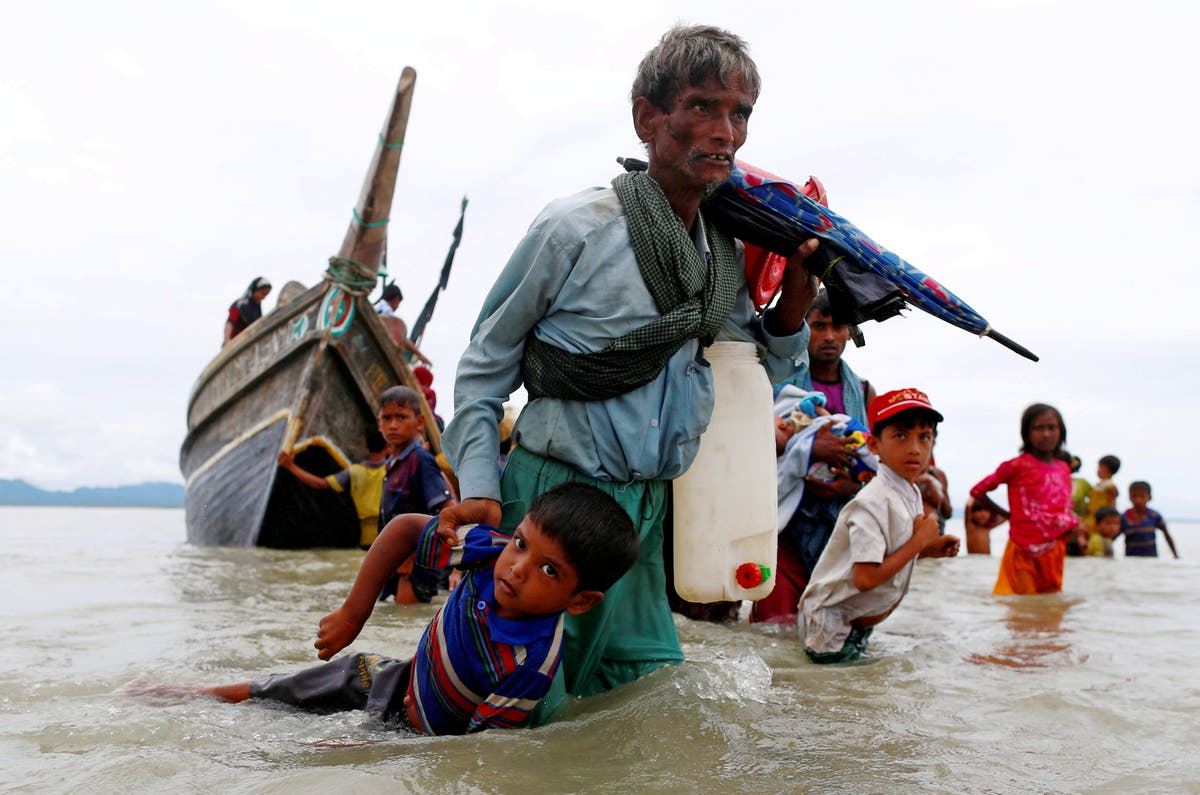
Danish Siddiqui, the Reuters journalist killed in crossfire last Friday when he was covering the war in Afghanistan, was a largely self-taught photographer who scaled the heights of his profession while documenting wars, riots and human suffering.
A native of New Delhi, Siddiqui, 38, is survived by his wife Rike and two young children.
He was part of a team that was awarded the Pulitzer Prize for Feature Photography in 2018 for documenting Myanmar’s Rohingya refugee crisis, a series described by the judging committee as “shocking photographs that exposed the world to the violence Rohingya refugees faced in fleeing Myanmar”.
An exhausted Rohingya refugee touches the shore after crossing the Bangladesh-Myanmar border by boat through the Bay of Bengal in 2017 (Danish Siddiqui/Reuters)
Friends and colleagues described a man who cared deeply about the stories he covered, carrying out meticulous research before embarking on assignments and always focusing on the people caught up in the news.
“Even in breaking news cycles, he would think about humanising a story, and you see that so often in his pictures, including those that won the Pulitzer and stories we have done in the last few years,” said Devjyot Ghoshal, a Reuters correspondent based in New Delhi and a neighbour of Siddiqui.
Siddiqui poses for a picture at Columbia University’s Low Memorial Library during the Pulitzer Prize giving ceremony in New York in 2018 (Danish Siddiqui/Reuters)
“Covering the Delhi riots together and the Covid-19 pandemic more recently – his most compelling images were about people, isolating the human element.”
A Reuters photographer since 2010, Siddiqui’s work has spanned wars in Afghanistan and Iraq, the Rohingya crisis, pro-democracy protests in Hong Kong and unrest in India.
A protester wearing a Guy Fawkes mask waves a flag during a Human Rights Day march organised by the Civil Human Rights Front in Hong Kong in 2019 (Danish Siddiqui/Reuters)
In recent months, his searing photographs capturing the coronavirus pandemic in India have spread across the world.
“Ninety per cent of the photography I have learnt has come from experimentation in the field,” Siddiqui once wrote.
People wait to cremate Covid-19 victims at a crematorium ground in New Delhi (Danish Siddiqui/Reuters)
A health worker reacts before the burial of a Central Reserve Police Force officer who was died of complications related to Covid-19 in New Delhi (Danish Siddiqui/Reuters)
“What I enjoy most is capturing the human face of a breaking story. I shoot for the common man who wants to see and feel a story from a place where he can’t be present himself.”
Ahmad Danish Siddiqui was born on 19 May 1983. He became a journalist after a Master’s degree in Mass Communications from Delhi’s Jamia Milia Islamia University.
Danish Siddiqui takes pictures as fireworks explode during a procession to mark Eid-e-Milad-ul-Nabi, birthday celebrations for the Prophet Mohammad, in Mumbai, India, in 2011 (Vivek Prakash/Reuters)
Siddiqui joined Reuters after stints as a correspondent with the Hindustan Times newspaper and the TV Today channel.
Last year, while covering sectarian unrest in a Delhi suburb, Siddiqui and Ghoshal saw a Muslim man being beaten by a frenzied Hindu mob.
A group of men chanting pro-Hindu slogans beat Mohammad Zubair, a Muslim, during protests sparked by a new citizenship law in New Delhi, India, in 2020 (Danish Siddiqui/Reuters)
The images were widely featured in international media, highlighting the danger of wider conflagration between India’s Hindu majority and sizeable Muslim minority. Siddiqui, a Muslim, had a narrow escape when the mob turned their attention on him.
Those photographs were part of a selection of Reuters pictures of the year in 2020.
Siddiqui provided video and text from his assignments as well as photographs.
A member of the Afghan special forces keeps watch as others search a house during a combat mission against the Taliban in Kandahar province, Afghanistan, in 2021 (Danish Siddiqui/Reuters)
Humvees that belong to Afghan special forces are seen destroyed during heavy clashes with the Taliban during the rescue mission of a police officer besieged at a check post in Kandahar province, Afghanistan (Danish Siddiqui/Reuters)
On his final assignment, he was embedded with Afghan special forces in the city of Kandahar.
Earlier last week, he was travelling with a convoy of commandos when it came under heavy fire from Taliban militants on the outskirts of Kandahar. He captured the drama in pictures, film and words.
© Reuters






